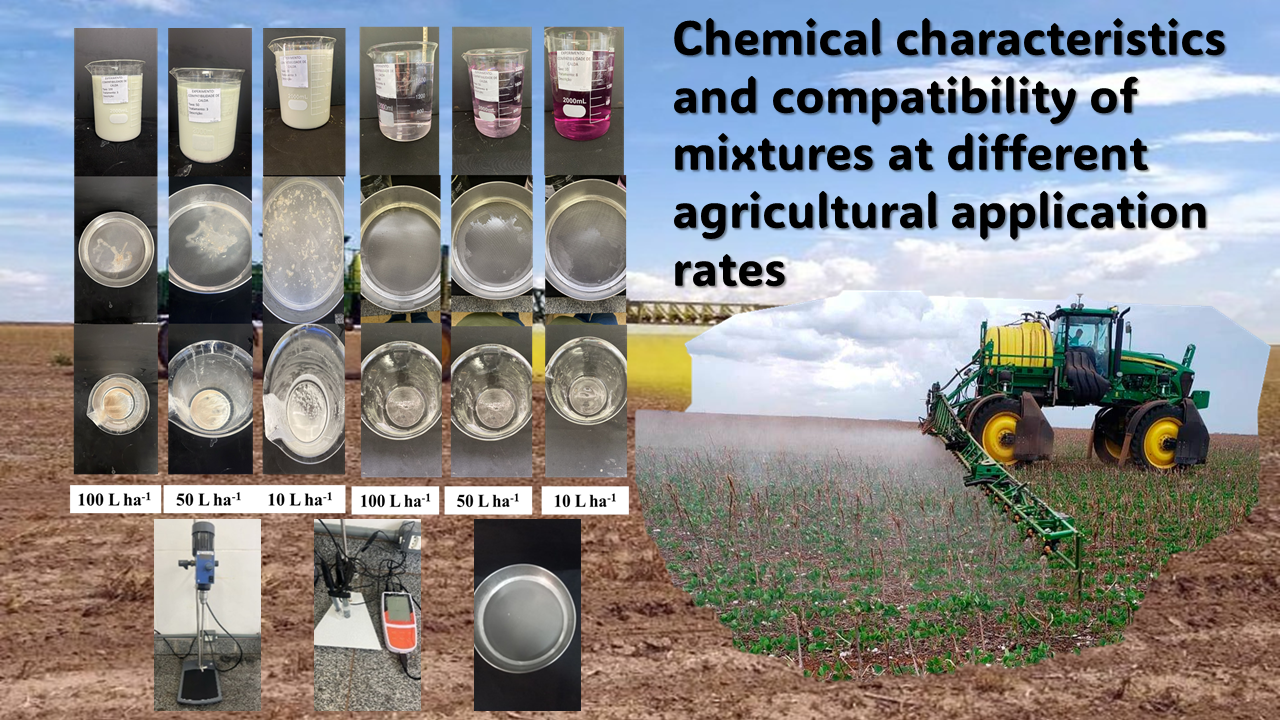Chemical characteristics and compatibility of mixtures at different agricultural application rates
DOI:
https://doi.org/10.14295/bjs.v3i7.612Keywords:
agrochemicals, spray additives, surfactants, application technology, dilution, pulverizationAbstract
Tank mixes are widely used to control weeds, fungi, insects, and nematodes to increase the control spectrum. However, little is known about the interactions that may occur due to the different types of formulations and products used. This study aimed to evaluate the interaction and compatibility between different classes of products (herbicides, fungicides, insecticides, biostimulants, foliar fertilizers, and adjuvants) on the physical-chemical parameters of sprays commonly used in farming. The concentration of the sprays was stipulated by adopting a spray volume between 100, 50, and 10 L ha-1 and the dose recommended by the manufacturers. The characteristics evaluated were physical compatibility (presence or absence of flocculation, sedimentation, phase separation, formation of lumps, oil separation, formation of crystals and cream, and foam formation) and chemical compatibility (pH and electrical conductivity). The products tested have different affinities with the adjuvants and it is not possible to generalize the recommendations. The physicochemical compatibility between products of different classes of action and the adjuvants evaluated is dependent on the rest period, with constant agitation being essential before and during application for Glifotal®, 2.4 D®, Smart Trio®, and B-Moly®, in addition to molecular incompatibility separation occurring between 5-30 min after preparation of syrup for 2.4 D®, Smart Trio®, B-Moly®, Fosert®, Glyphosate®, Zethamaxx®, Bravonil®, Engeo®, Completo®, Plant Start®, Smart Cooper®, Manni Plex cal mg®, Manni Plex k® and Smart Zn®. pH also has a strong influence in some mixtures of syrups where flocculation occurred for the products Bravonil®, Engeo®, Completo®, Plant Start®, Smart Cooper®, and Smart Zn®, as well as the formation of lumps due to the concentration for Engeo®, Completo®, Plant Start®, and Smart Cooper®. It is concluded that dosages, homogenization, interactions between molecules of the same or different classes, and physicochemical parameters such as pH and electrical conductivity influence the obtaining of compatible application grouts.
References
Abnt. (2015). Norma Brasileira. NBR 133875. Agrotóxicos e afins - Avaliação de compatibilidade físico-química: Pesticides - Physical Chemistry Compatibility, 12 p.
Andrade, C. L. L., Silva, A. G., Melo, G. B., Ferreira, R. V., Moura, I. C. S., & Siqueira, G. G. C. (2018). Bioestimulantes derivados de Ascophyllum nodosum associados ao glyphosate nas características Agronômicas da soja RR®. Revista Brasileira de Herbicidas, 17(3), e592. http://dx.doi.org/10.7824/rbh.v17i3.592 DOI: https://doi.org/10.7824/rbh.v17i3.592
Andef. (2004). Associação Nacional de Defesa Vegetal. Manual de tecnologia de aplicação - Campinas, São Paulo: Linea Creativa, 2004.
Antuniassi, U. R., & Baio, F. H. R. (2006). Tecnologia de aplicação de defensivos. Revista Plantio Direto, 15(4), 17-22. https://www.dpaviacao.com.br/unesp2.pdf
Antuniassi, U. R. (2021). Tecnologia dentro do tanque. Revista Plantio Direto. https://plantiodireto.com.br/artigos/263
Araújo, D. (2021). Preparo da calda e sua interferência na eficácia de agrotóxicos. In: INFOBIOS. Access in: March 01, 2024.
Azevedo, L. A. S. (2011). A importância da água nas misturas de tanque. 1 ed. Rio de Janeiro. IMOS Gráfica e Editora.
Belz, R. G., Cedergreen, N., & Sørensen, H. (2008). Hormesis in mixture – Can it be predicted? Science of the Total Environment, 404(1), 77-87. https://doi.org/10.1016/j.scitotenv.2008.06.008 DOI: https://doi.org/10.1016/j.scitotenv.2008.06.008
Bessani, J. P. P., Yamashita, O. M., Carvalho, M. A. C., Campos, O. R., Caione, G., & Koga, P. S. (2022). Associação entre adubo foliar e herbicida auxínico no manejo de Vernonia polyanthes e recuperação de forrageira Panicum maximum. Revista Princípia, 59(2), 327-341. http://dx.doi.org/10.18265/1517-0306a2021id4718 DOI: https://doi.org/10.18265/1517-0306a2021id4718
Buhler, D. D., & Burnside, O. C. (1983). Effect of water quality, carrier volume, and acid on glyphosate phytotoxicity. Weed Science, 31(2), 163-169. https://doi.org/10.1017/S0043174500068776 DOI: https://doi.org/10.1017/S0043174500068776
Carvalho, S. J. P., Filho, H. T., Dias, A. C. R., Nicolai, M., & Christoffoleti, P. J. (2011). Participação do nitrogênio na indução de injúrias foliares e na eficácia do herbicida glyphosate. Revista Ceres, 58(4), 516-524. https://doi.org/10.1590/S0034-737X2011000400017 DOI: https://doi.org/10.1590/S0034-737X2011000400017
Costa, L. L., Santos, T. C. M., Almeida, D. P., Ferreira, M. C., Leão-Araújo, É. F., & Timossi, P. C. (2020). Compatibilidade físico-química de diferentes doses e misturas de herbicidas. Revista Brasileira de Herbicidas, 19(3), 1-8. https://doi.org/10.7824/rbh.v19i3 DOI: https://doi.org/10.7824/rbh.v19i3.713
Costa, L. L., Silva, H. J. P. S., Almeida, D. P., Ferreira, M. C., & Pontes, N. C. (2017). Droplet spectra and surface tension of spray solutions by biological insecticide and adjuvants. Engenharia Agrícola, 37(2), 292-301. https://doi.org/10.1590/1809-4430-Eng.Agric.v37n2p292-301/2017 DOI: https://doi.org/10.1590/1809-4430-eng.agric.v37n2p292-301/2017
Cunha, J. P. A. R., & Alves, G. S. (2009). Características físico-químicas de soluções aquosas com adjuvantes de uso agrícola. Interciência, 34(9), 655-659. https://ve.scielo.org/scielo.php?pid=S0378-18442009000900012&script=sci_arttext&tlng=pt
Cunha, L. P., & Martins, K. V. (2022). Avaliação de compatibilidade de herbicida. Revista Perquirere, 19(2), 16-35. https://doi.org/10.1590/S0100-83582017350100090
Decaro Jr, S. T., Ferreira, M. C., & Lasmar, O. (2015). Physical characteristics of oily spraying liquids and droplets formed on coffee leaves and glass surfaces. Engenharia Agrícola, 35(3), 588-600. https://doi.org/10.1590/1809-4430-Eng.Agric.v35n3p588-600/2015 DOI: https://doi.org/10.1590/1809-4430-Eng.Agric.v35n3p588-600/2015
Fritz, B. K., Hoffmann, W. C., Kruger, G. R., Henry, R. S., Hewitt, A., & Czaczyk, Z. (2014). Comparison of drop size data from ground and aerial application nozzles at three testing laboratories. Atomization Sprays, 24(2), 181-192. https://www.dl.begellhouse.com/journals/6a7c7e10642258cc,270552c86f881aaf,0e7388b61d186e85.html DOI: https://doi.org/10.1615/AtomizSpr.2013009668
Gandini, E. M. M., Costa, E. S., Santos, J. B., Soares, M. A., Barroso, G. M., Corrêa, J. M., Carvalho, A. G., & Zanuncio, J. C. (2020). Compatibility of pesticides and/or fertilizers in tank mixtures. Journal of Cleaner Production, 268, 122152. https://doi.org/10.1016/j.jclepro.2020.122152 DOI: https://doi.org/10.1016/j.jclepro.2020.122152
Gazziero, D. L. P. (2015). Misturas de agrotóxicos em tanques nas propriedades agrícolas do Brasil. Planta Daninha, 33(1), 83-92. https://doi.org/10.1590/S0100-83582015000100010 DOI: https://doi.org/10.1590/S0100-83582015000100010
Ikeda, F. S. (2013). Resistência de plantas daninhas em soja resistente ao glifosato. Informe Agropecuário, 4(276).
Kissmann, K. G. (1997). Adjuvantes para caldas de produtos agrotóxicos. In: Congresso Brasileiro de Ciência das Plantas Daninhas, 21, Caxambu. Palestras e mesas redondas...Viçosa: Sociedade Brasileira da Ciência das Plantas Daninhas, 61-77 p.
Lopes, A. F. (2019). Uso de antiespumantes na pulverização. Maissoja.com.br. Available in: https://maissoja.com.br/uso-de-antiespumantes-na-pulverizacao/ Access in: May 31, 2024.
Maciel, C. D. G., Gerra, N., Oliveira Neto, A. M., Poletine, J. P., Bastos, S. L. W., & Dias, N. M. S. (2010). Tensão superficial estática de misturas em tanque de Glyphosate + Chlorimuron-Ethyl isoladas ou associadas a adjuvantes. Planta Daninha, 28(3), 673-685. https://doi.org/10.1590/S0100-83582010000300025 DOI: https://doi.org/10.1590/S0100-83582010000300025
Matuo, T., Pio, L. C., & Ramos, H. H. (2001). Módulo 2 – tecnologia de aplicação dos agroquímicos e equipamentos. In: Associação Brasileira de Ensino.
Mendonça, C. G. (2000). Algumas características da superfície foliar de diversas plantas daninhas monocotiledôneas. Dissertação de Mestrado em Agronomia pela Universidade Estadual Paulista Júlio de Mesquita Filho, Botucatu, São Paulo, Brasil, 89 p.
Mendonça, C. G., & Raetano, C. G. (2007). Tensão superficial estática de soluções aquosas com óleos minerais e vegetais utilizados na agricultura. Engenharia Agrícola, 27, 16-23. https://doi.org/10.1590/S0100-69162007000200003 DOI: https://doi.org/10.1590/S0100-69162007000200003
Moraes, H. M. F., Costa, J. O., Pereira, G. A. M., Silva, A. A., & Paixão, G. P. (2019). Physical compatibility and stability of pesticide mixtures at different spray volumes. Planta Daninha, 37, e0192214004. https://doi.org/10.1590/S0100-83582019370100125 DOI: https://doi.org/10.1590/s0100-83582019370100125
Nbr. (2014). Associação Brasileira de Normas Técnicas – ABNT. NBR 13875:2014. Agrotóxicos e afins – Avaliação de compatibilidade físico-química. Rio de Janeiro, 12 p.
Petter, A. F., Segate, D., Almeida, F. A., Neto, F. A., Pacheco, L. P. (2012). Incompatibilidade física de misturas entre herbicidas e inseticidas. Planta Daninha, 30(2), 449-457. https://doi.org/10.1590/S0100-83582012000200025
Petter, A. F., Segate, D., Almeida, F. A., Neto, F. A., & Pacheco, L. P. (2013). Incompatibilidade física de misturas entre inseticidas e fungicidas. Comunicata Scientiae, 4(2), 129-138. DOI: https://doi.org/10.1590/S0100-83582012000200025
Popa, D. G., Fătu, C., Sicuia, O., Buburuz, A., Dinu, S., Dinu, M., Dudoiu, R., Constantinescu, F., Andrei, A-M., & Mincea, C. (2014). Efficacy of two compatible mixtures of chemical and microbiological products against main maize pests. Romanian Journal of Plant Protection, VII, 69-74.
Queiroz, A. A., Martins, J. A. S., & Cunha, J. P. A. R. (2008). Adjuvantes e qualidade da água na aplicação de agrotóxicos. Bioscience Journal, 24, 8-19.
Rakes, M., Grützmacher, A. D., Pazini, R. A., & Schaedler, C. E. (2017). Physicochemical compatibility of agrochemical mixtures in spray tanks for paddy field rice crops. Planta Daninha, 35, e017165185. https://doi.org/10.1590/S0100-83582017350100090 DOI: https://doi.org/10.1590/s0100-83582017350100090
Ribeiro, R. P. M., Costa, L. L., Leão-Araújo, É. F., & Oliveira, A. (2021). Compatibilidade físico-química de caldas fungicidas e adjuvantes. Scientific Electronic Archives, 13(5), 35-41. http://dx.doi.org/10.36560/14520211275 DOI: https://doi.org/10.36560/14520211275
Sasaki, R. S., Teixeira, M. M., Santiago, H., Madureira, R. P., Maciel, C. F. S., & Fernandes, H. C. (2015). Adjuvantes nas propriedades físicas da calda, espectro e eficiência de eletrificação das gotas utilizando a pulverização eletrostática. Ciência Rural, 45(02), 274-279. https://doi.org/10.1590/0103-8478cr20131604 DOI: https://doi.org/10.1590/0103-8478cr20131604
Schampheleire, M. D., Nuyttens, D., Baetens, K., Cornelis, W., Gabriels, D., & Spanoghe, P. (2009). Effects on pesticide spray drift of the physicochemical properties of the spray liquid. Precision Agriculture, 10, 409-420. https://doi.org/10.1007/s11119-008-9089-6 DOI: https://doi.org/10.1007/s11119-008-9089-6
Silva, J. F., Silva, J. F., Ferreira, L. R., & Ferreira, F. A. (2007). Herbicidas: absorção, translocação, metabolismo, formulação e misturas. In: Silva, A. A., & Silva, J. F. (Ed.). Tópicos em manejo de plantas daninhas. Viçosa: Universidade Federal de Viçosa, 367 p.
Silva-Matte, S. C., Costa, N. V., Pauly, T., Coltro-Roncato, S., Oliveira, A. C., Castagnara, D. D. (2014). Variabilidade da quebra da tensão superficial da gota pelo adjuvante (Aureo®) em função de locais de captação de água. Revista Agrarian, 7, 264-270.
Stumm, W., & Morgan, J. J. (1996). Aquatic chemistry: Chemical equilibria and rates in natural waters. 3. ed. New York: J. Wiley, 1022 p.
Xu, L., Zhu, H., Ozkan, E., Bagley, B., & Krause, C. R. (2011). Droplet evaporation and spread on waxy and hairy leaves associated with the type and concentration of adjuvants. Pest Management Science, 67(7), 842-851. https://doi.org/10.1002/ps.2122 DOI: https://doi.org/10.1002/ps.2122
Wanamarta, G., & Penner, D. (1989). Foliar absorption of herbicides. Reviews of Weed Science, 4, 215-232.
Whitford, F. (2009). Impact of water quality on pesticide performance. Purdue Extension, Purdue University 86 p.
Wolf, R. E., Gardisser, D. R., Minihan, C. L. (2003). Field comparisons for drift reducing/deposition aid tank mixes. St. Joseph: ASAE, 17 p.

Downloads
Published
How to Cite
Issue
Section
License
Copyright (c) 2024 Paulo Henrique Pessoa, Hemerson Alves Silva, Letícia da Silva Lima, Rafael Borges de Assis, Nathan Alves Neres, Jaqueline Chagas de Almeida, Fernando Rodrigues Cabral Filho, Christiano Lima Lobo de Andrade

This work is licensed under a Creative Commons Attribution 4.0 International License.
Authors who publish with this journal agree to the following terms:
1) Authors retain copyright and grant the journal right of first publication with the work simultaneously licensed under a Creative Commons Attribution License that allows others to share the work with an acknowledgement of the work's authorship and initial publication in this journal.
2) Authors are able to enter into separate, additional contractual arrangements for the non-exclusive distribution of the journal's published version of the work (e.g., post it to an institutional repository or publish it in a book), with an acknowledgement of its initial publication in this journal.
3) Authors are permitted and encouraged to post their work online (e.g., in institutional repositories or on their website) prior to and during the submission process, as it can lead to productive exchanges, as well as earlier and greater citation of published work.




